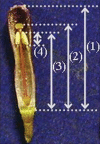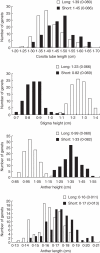QTL analysis of heterostyly in Primula sieboldii and its application for morph identification in wild populations
- PMID: 21693668
- PMCID: PMC3119624
- DOI: 10.1093/aob/mcr117
QTL analysis of heterostyly in Primula sieboldii and its application for morph identification in wild populations
Abstract
Background and aims: Primula sieboldii is a perennial clonal herb that is distributed around the Sea of Japan and is endangered in Japan. Its breeding system is characterized by heteromorphic self-incompatibility, and the morph ratio within a population is very important for reproductive success. The aims of this study were to construct a linkage map, map the S locus as a qualitative trait and quantitative trait loci (QTLs) for floral morphological traits related to heterostyly, and predict the morph type in wild populations by using molecular markers for devising a conservation strategy.
Methods: A linkage map was constructed with 126 markers. The QTLs for four floral traits and the S locus were mapped. Using the genotypes of loci that were located near both the S locus and the QTLs with large effects, morphs of 59 wild genets were predicted.
Key results: The linkage map consisted of 14 linkage groups (LGs). The S locus was mapped to LG 7. Major QTLs for stigma and anther heights were detected in the same region as the S locus. These QTLs exhibited high logarithm of the odds scores and explained a high percentage of the phenotypic variance (>85 %). By analysing these two traits within each morph, additional QTLs for each trait were detected. Using the four loci linked to the S locus, the morphs of 43 genets in three wild populations could be predicted.
Conclusions: This is the first report of a linkage map and QTL analysis for floral morphology related to heterostyly in P. sieboldii. Floral morphologies related to heterostyly are controlled by the S locus in LG 7 and by several QTLs in other LGs. Additionally, this study showed that molecular markers are effective tools for investigating morph ratios in a population containing the non-flowering individuals or during the non-flowering seasons.
Figures



Similar articles
-
Integration of genetic and physical maps of the Primula vulgaris S locus and localization by chromosome in situ hybridization.New Phytol. 2015 Oct;208(1):137-48. doi: 10.1111/nph.13373. Epub 2015 Apr 9. New Phytol. 2015. PMID: 25865367 Free PMC article.
-
The draft genome of Primula veris yields insights into the molecular basis of heterostyly.Genome Biol. 2015 Jan 24;16(1):12. doi: 10.1186/s13059-014-0567-z. Genome Biol. 2015. PMID: 25651398 Free PMC article.
-
High-density genetic map construction and QTLs identification for plant height in white jute (Corchorus capsularis L.) using specific locus amplified fragment (SLAF) sequencing.BMC Genomics. 2017 May 8;18(1):355. doi: 10.1186/s12864-017-3712-8. BMC Genomics. 2017. PMID: 28482802 Free PMC article.
-
Converging on long and short: The genetics, molecular biology and evolution of heterostyly.Curr Opin Plant Biol. 2025 Jun;85:102731. doi: 10.1016/j.pbi.2025.102731. Epub 2025 May 3. Curr Opin Plant Biol. 2025. PMID: 40319570 Review.
-
The nature and identification of quantitative trait loci: a community's view.Nat Rev Genet. 2003 Nov;4(11):911-6. doi: 10.1038/nrg1206. Nat Rev Genet. 2003. PMID: 14634638 Free PMC article. Review.
Cited by
-
Supergenes and their role in evolution.Heredity (Edinb). 2014 Jul;113(1):1-8. doi: 10.1038/hdy.2014.20. Epub 2014 Mar 19. Heredity (Edinb). 2014. PMID: 24642887 Free PMC article. Review.
-
Integration of genetic and physical maps of the Primula vulgaris S locus and localization by chromosome in situ hybridization.New Phytol. 2015 Oct;208(1):137-48. doi: 10.1111/nph.13373. Epub 2015 Apr 9. New Phytol. 2015. PMID: 25865367 Free PMC article.
-
Two floral forms in the same species-distyly.Planta. 2023 Sep 1;258(4):72. doi: 10.1007/s00425-023-04229-6. Planta. 2023. PMID: 37656285 Review.
-
Primula vulgaris (primrose) genome assembly, annotation and gene expression, with comparative genomics on the heterostyly supergene.Sci Rep. 2018 Dec 18;8(1):17942. doi: 10.1038/s41598-018-36304-4. Sci Rep. 2018. PMID: 30560928 Free PMC article.
References
-
- Barrett SCH, Shore JS. New insights on heterostyly: comparative biology, ecology and genetics. In: Franklin-Tong VE, editor. Self-incompatibility in flowering plants. Evolution, diversity, and mechanisms. Heidelberg: Springer; 2008. pp. 1–32.
-
- Bartkowska MP, Johnston MO. Quantitative genetic variation in populations of Amsinckia spectabilis that differ in rate of self-fertilization. Evolution. 2009;65:1103–1117. - PubMed
-
- Darwin C. The different forms of flowers on plants of the same species. London: John Murray; 1877.
-
- DeWinton D, Haldane JBS. The genetics of Primula sinensis. III. Linkage in the diploid. Journal of Genetics. 1935;31:67–100.
-
- Dowrick VPJ. Heterostyly and homostyly in Primula obconica. Heredity. 1956;10:219–236.

